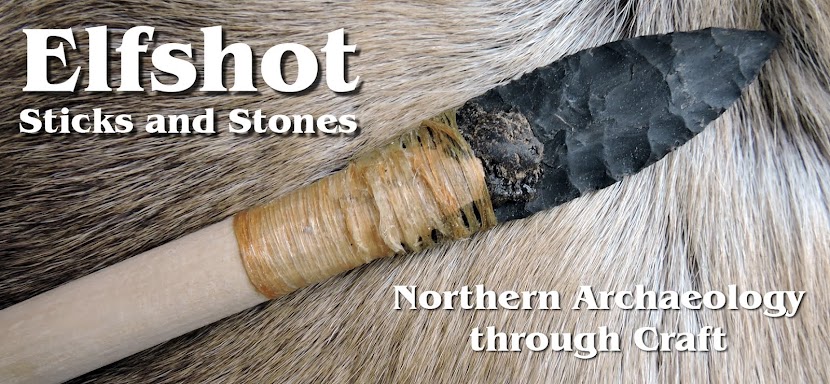 The Rooms demo went well yesterday. There was a steady stream of people throughout the afternoon. I finished one point and started on a second biface. Almost every kind of stone tool from every precontact culture found in Newfoundland and Labrador was made from Ramah chert on occasion, but I'm always drawn to the Maritime Archaic stemmed points that came from Saglek Bay.
The Rooms demo went well yesterday. There was a steady stream of people throughout the afternoon. I finished one point and started on a second biface. Almost every kind of stone tool from every precontact culture found in Newfoundland and Labrador was made from Ramah chert on occasion, but I'm always drawn to the Maritime Archaic stemmed points that came from Saglek Bay.Jim Tuck wrote this about Ramah Chert in 1976 and it sums up why I like making the Saglek style stemmed points:
Ramah chert apparently has the qualities that allow it to be easily flaked into tools and weapons that are thin, symmetrical, and appear to us to be very well and carefully made. In fact this material may have been so superior in its flaking attributes to quartzite, quartz crystal, and other substances formerly in use, that it actually brought about some significant changes in the form (rather than the "finish") of many Maritime Archaic chipped stone artifacts. The thick, rather small projectile points, made prior to about 5,000 years ago, are replaced by much thinner examples, very flat in cross-section, with longer stems, much more even edges, surfaces, and a greater degree of symmetry. (Jim Tuck, Newfoundland and Labrador Prehistory 1976)
 Some tools types are so strongly associated with a particular type of stone that they just don't look right unless they are made from that specific kind of rock. That's the case with Ramah Chert and the Saglek style of stemmed points. I like the idea that discovering this new source of stone 5000 years ago actually allowed the Maritime Archaic people to create new kinds styles of tools.
Some tools types are so strongly associated with a particular type of stone that they just don't look right unless they are made from that specific kind of rock. That's the case with Ramah Chert and the Saglek style of stemmed points. I like the idea that discovering this new source of stone 5000 years ago actually allowed the Maritime Archaic people to create new kinds styles of tools.Photo Credits:
1, 3: Tim Rast
2: Jim Tuck, Newfoundland and Labrador Prehistory, National Museum of Man 1976
Photo Captions:
1: Ramah Chert Maritime Archaic Reproduction knapped point
2: Ramah Chert artifacts from Saglek Bay
3: Ramah point and antler pressure flaker used to make it

No comments:
Post a Comment